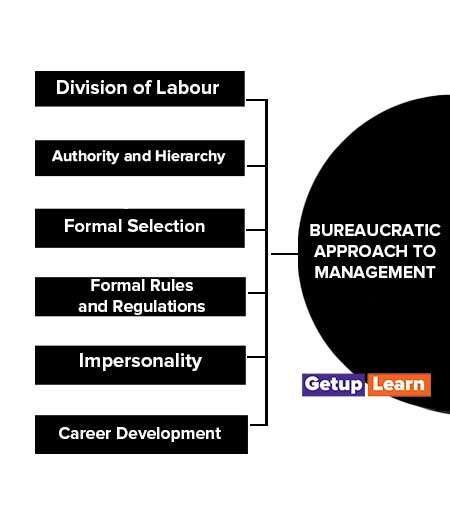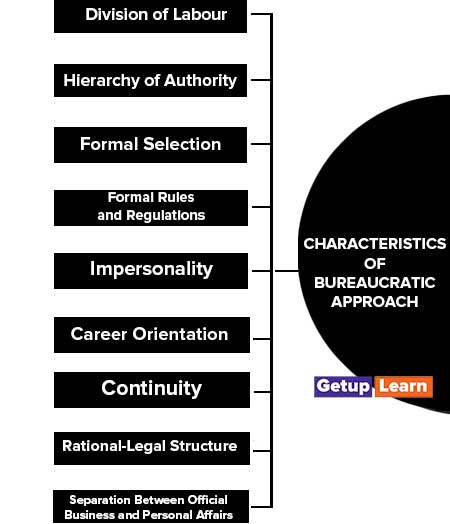Bureaucratic management refers to a management style characterized by a highly centralized and structured organization, with a clear hierarchy and a strong emphasis on rules and regulations. This type of management is often associated with large public sector organizations, but can also be found in private sector companies that have complex operations and a need for detailed control and oversight.

The main advantages of bureaucratic management include a clear chain of command, a high degree of predictability, and a high level of control over the organization. However, it can also be inflexible and slow to adapt to change, which can be a disadvantage.
Table of Contents
Bureaucratic System Approach
Max Weber, a German Social Scientist and Philosopher made a valuable contribution to the general administration theory through his concept of Bureaucracy. According to Weber, there are three types of authority systems as follows:

It is based on the extraordinary qualities or magnetic personality of the leader, e.g. Henri Ford of Ford Motors. However, this type of authority structure suffers from the problem of instability. It comes to end with the leader. People may not accept the successor of such a person as a leader.
Here a person enjoys authority because of his status derived by inheritance. The extent of authority is decided by custom. Traditional authority system ignores whether the particular person has the necessary leadership qualities and competencies.
Bureaucracy
According to Weber both the charismatic and traditional authority systems are not suitable for large business organizations because they are person-centred and unstable in nature. Hence, Weber has advocated the Bureaucracy model based on rationality and legality.
Bureaucratic Approach to Management
The bureaucratic approach to management is a management style that is characterized by a highly centralized and structured organization, with a clear hierarchy and a strong emphasis on rules and regulations.
This approach is often associated with large public sector organizations, but can also be found in private sector companies that have complex operations and a need for detailed control and oversight. The main goal of the bureaucratic approach is to achieve maximum efficiency and productivity by implementing clear policies, procedures, and systems.
The bureaucratic approach is associated with the work of Max Weber, a German sociologist, who developed the concept of a “bureaucracy” as a form of organization characterized by a hierarchical structure, a clear division of labour, and a system of rules and regulations. Weber believed that bureaucracy was the most efficient and rational form of organization and that it was the best way to achieve goals and objectives.
These are the following bureaucratic approach to management explained below:
- Division of Labour
- Authority and Hierarchy
- Formal Selection
- Formal Rules and Regulations
- Impersonality
- Career Development

Division of Labour
Max Weber was of the view that the division of work should be based on the labour or efforts required to perform the job, not a quantitative division.
There should be a proper alignment of authority and hierarchy in an organisation. The authority should be delegated to subordinates in order of hierarchy.
Formal Selection
Formal selection is given priority over scientific selection. He was of the view that equal opportunity must be given to every eligible candidate. This needs things to be organised in a formal manner.
Formal Rules and Regulations
There should be clearly laid down rules for everything. Be it small activity or a big one, the model guidelines must be followed in order to ensure proper implementation.
Impersonality
Impersonality at each level is necessary to gain the belief of the common man who wants things in the proper manner. Honesty is the system that must be inculcated to implement formal rules and regulations.
Career Development
The system must show a career growth path. The employee should get equal opportunities for career development.
Characteristics of Bureaucratic Approach
Let’s discussed the characteristics of bureaucratic approach:
- Division of Labour
- Hierarchy of Authority
- Formal Selection
- Formal Rules and Regulations
- Impersonality
- Career Orientation
- Continuity
- Separation Between Official Business and Personal Affairs
- Rational-Legal Structure

Division of Labour
In the bureaucracy, jobs are broken into simple routines and well-defined tasks and assigned to various employees on the basis of their abilities, skills and aptitudes.
Bureaucracy works on a well-defined hierarchy of authority. Higher officials or offices supervise lower officials or offices and the lower officials/offices have the right of appeal.
Formal Selection
All persons in the organization are selected and placed on the basis of their technical qualifications.
Formal Rules and Regulations
The organization functions according to formal rules and regulations. These rules and regulations are in written form and communicated to all employees. The use of formal rules and regulations ensures uniformity in action and helps the management to control the employees.
Impersonality
There is no place for emotions, sentiments and personal attachment. Rules and regulations supersede the persons in the organization and are applied uniformly avoiding involvement with the personalities and personal preferences of employees.
Career Orientation
In a bureaucratic organization, the officers are ‘professionals’ rather than owners of the organization. They derive authority because of the office/post they hold and work for a fixed salary. They have the prospects of regular advancement in the organization. They are appointed on a full-time basis.
Continuity
The official business is conducted on a continuous basis. The organization enjoys continuity of operations because of the rational-legal authority structure.
Separation Between Official Business and Personal Affairs
The official business of employees and their personal affairs are treated as two separate things. There is a separation between official revenue and personal income. Officials do not own the resources required for performing their duties. However, they are accountable for the use of official resources.
Rational-Legal Structure
Weber’s bureaucracy model is characterized by rationality and legality. It is rational in the sense that means is expressly allotted for achieving predetermined goals. It is called ‘legal’ because authority is attached to the office and is exercised impersonally through the system of rules and regulations.
Criticism of Bureaucracy Theory
These are the criticism of bureaucracy theory:
- The bureaucracy model fails to meet the need of job satisfaction and creativity and hence it is not useful in modern times.
- Bureaucracy is overridden by rules and regulations, losing the ‘human element’.
- The rules and procedures may be misused by the higher authority to punish the employees.
- Officials give excessive importance to following rules and procedures. They pay less attention to the achievement of overall goals.
- According to Peter Drucker, “procedures are wrongly considered as a substitute for judgment”.
- Bureaucracy does not consider the existence of an informal organization and its role in management.
- The human resources may not be fully utilized due to dishonour, fear of reprisals etc.
What are the bureaucratic approaches?
The following are the bureaucratic approaches:
1. Division of Labour
2. Authority and Hierarchy
3. Formal Selection
4. Formal Rules and Regulations
5. Impersonality
6. Career Development.
What are the characteristics of bureaucratic approaches?
The following are the characteristics of bureaucratic approaches:
1. Division of Labour
2. Hierarchy of Authority
3. Formal Selection
4. Formal Rules and Regulations
5. Impersonality
6. Career Orientation
7. Continuity
8. Separation Between Official Business and Personal Affairs
9. Rational-Legal Structure.















